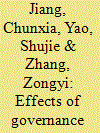| Srl | Item |
| 1 |
ID:
092540


|
|
|
|
|
| Publication |
2009.
|
| Summary/Abstract |
China has accelerated banking reform since joining the Word Trade Organisation (WTO) in 2001. Employing a stochastic distance function approach, this paper examines bank technical efficiency and differentiates the static, selection and dynamic governance effects on bank efficiency for the 11-year period 1995-2005. The results show that bank efficiency has improved. Joint-stock ownership is associated with better performance in terms of profitability than state ownership (static effect). Strong selection effects are found for both foreign acquisition and going public reform strategies. Foreign acquisition may benefit domestic banks by efficiency gains in the long run, but privatization via initial public offerings (IPOs) appears to have only some short-term effects.
|
|
|
|
|
|
|
|
|
|
|
|
|
|
|
|
| 2 |
ID:
180144


|
|
|
|
|
| Summary/Abstract |
The increasing penetration of intermittent renewables and the accelerated climate change are challenging the power system operation in China, and understanding the cost of reducing power outage durations is essential in supporting the equipment maintenance, infrastructure investments and regulation policies. Therefore, this study first uses production theory combined with a parametric distance function approach to estimate the marginal costs (MCs) of reducing power outage durations by 1 h. Then, we establish a fixed-effects panel data model to investigate the impacts of different environmental factors on the estimated MCs. Finally, the estimated MCs are applied to the evaluations and designs of interruption compensation prices in the demand response mechanism. The significant findings are that: (1) The national MC shows an increasing trend during the period from 2002 to 2017 in China, ranging from 1.27 billion yuan/hour to 11.63 billion yuan/hour. (2) The MCs vary substantially among different provinces, and provinces with better reliability levels will have higher MCs. (3) The current compensations for power outages are only about 6% to 61% of the estimated MCs, indicating that grid companies would like to pay for the compensations rather than to enhance the system reliability from the supply side.
|
|
|
|
|
|
|
|
|
|
|
|
|
|
|
|
| 3 |
ID:
137695


|
|
|
|
|
| Summary/Abstract |
Shanghai, one of the most developed cities in China, is implementing a pilot regional carbon emission trading scheme. Estimating the marginal abatement costs of CO2 emissions for the industrial sectors covered in Shanghai's emission trading scheme provides the government and participating firms useful information for devising compliance policies. This paper employs multiple distance function approaches to estimating the shadow prices of CO2 emissions for Shanghai industrial sectors. Our empirical results show that the overall weighted average of shadow price estimates by different approaches ranges between 394.5 and 1906.1 Yuan/ton, which indicates that model choice truly has a significant effect on the shadow price estimation. We have also identified a negative relationship between the shadow price of CO2 emissions and carbon intensity, and the heavy industries with higher carbon intensities tend to have lower shadow prices. It has been suggested that Shanghai municipal government take various measures to improve its carbon market, e.g. using the marginal abatement costs of participating sectors/firms as a criterion in the initial allocation of carbon emission allowances.
|
|
|
|
|
|
|
|
|
|
|
|
|
|
|
|